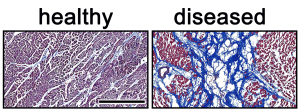We have identified a new potential target for the treatment of heart failure
Heart failure is the leading cause of death worldwide. Scientists at the International Clinical Research Centre (ICRC) in Brno have identified a potential target for the treatment of heart disease that is related to the location and function of a protein called hnRNPC. They have now published their findings in the prestigious journal Science Translational Medicine, opening up the possibility of finding new treatments.
Cardiac diseases are accompanied by intense modifications of the architecture of the heart muscle tissue, a process which is defined as negative remodeling. During this process, a scar is formed within the muscle which impairs its contractile function and eventually leads to the failure of the organ in the long run.
Despite the advances in therapies and prevention, heart failure remains the leading cause of mortality worldwide. This pandemic accounts for over 1.8 million deaths every year, which means more than one in three deaths in the world are caused by heart failure.
For many years, scientists have known that the progression of heart failure is associated with the modification of the internal functioning of the cardiac cells, including those processes controlling the maturation of RNA molecules. These processes are important for the production of the structural proteins, which account for the ability of cardiac cells to produce force, contract and make the heart beat. Altered RNA metabolism in the diseased heart is considered largely responsible for the disease.
The research group led by Dr. Giancarlo Forte at the International Clinical Research Center (ICRC) of St. Anne’s University Hospital Brno and Faculty of Medicine, Masaryk University, finally identified how the formation of the scar in the heart leads to altered RNA metabolism by affecting the localization and function of a protein named hnRNPC. These results might pave the way to the design of new treatments based on the interference with the displacement of the protein.
The research, which is the subject of a publication on the leading international journal Science Translational Medicine, started in 2015 and was conducted mostly on human patient samples thanks to the decisive collaboration of the Center of Cardiovascular and Transplant Surgery (Centrum kardiovaskulární a transplantační chirurgie, CKTCH) Brno. Other collaborators of the study include researchers from Central European Institute of Technology (CEITEC) in Brno, as well as from the University of Melbourne (Australia), King’s College, Imperial College London and the University of Surrey (UK).
Microscopic images of tissue from a healthy (left) and diseased (right) human heart. The muscle tissue is shown in red and the appearance of the scar in the diseased heart is shown in blue.
The research was generously supported by the European Regional Development Fund – Projects ENOCH (No. CZ.02.1.01/0.0/0.0/16_019/0000868) and MAGNET (No. CZ.02.1.01/0.0/0.0/15_003/0000492), European Union Horizon 2020 Research and Innovation Program NANOSUPREMI (No. 690901) and the Czech Science Foundation.
Reference:
Martino F, Mysore Varadajan N, Perestrelo AR, Hejret V, Durikova H, Vukic D, Horvath V, Cavalieri F, Caruso F, Albihlal WS, Gerber AP, O’Connell MA, Vanacova S, Pagliari S, Forte G.
The mechanical regulation of RNA binding protein hnRNPC in the failing heart. Sci Transl Med (2022) https://www.science.org/doi/10.1126/scitranslmed.abo5715.


